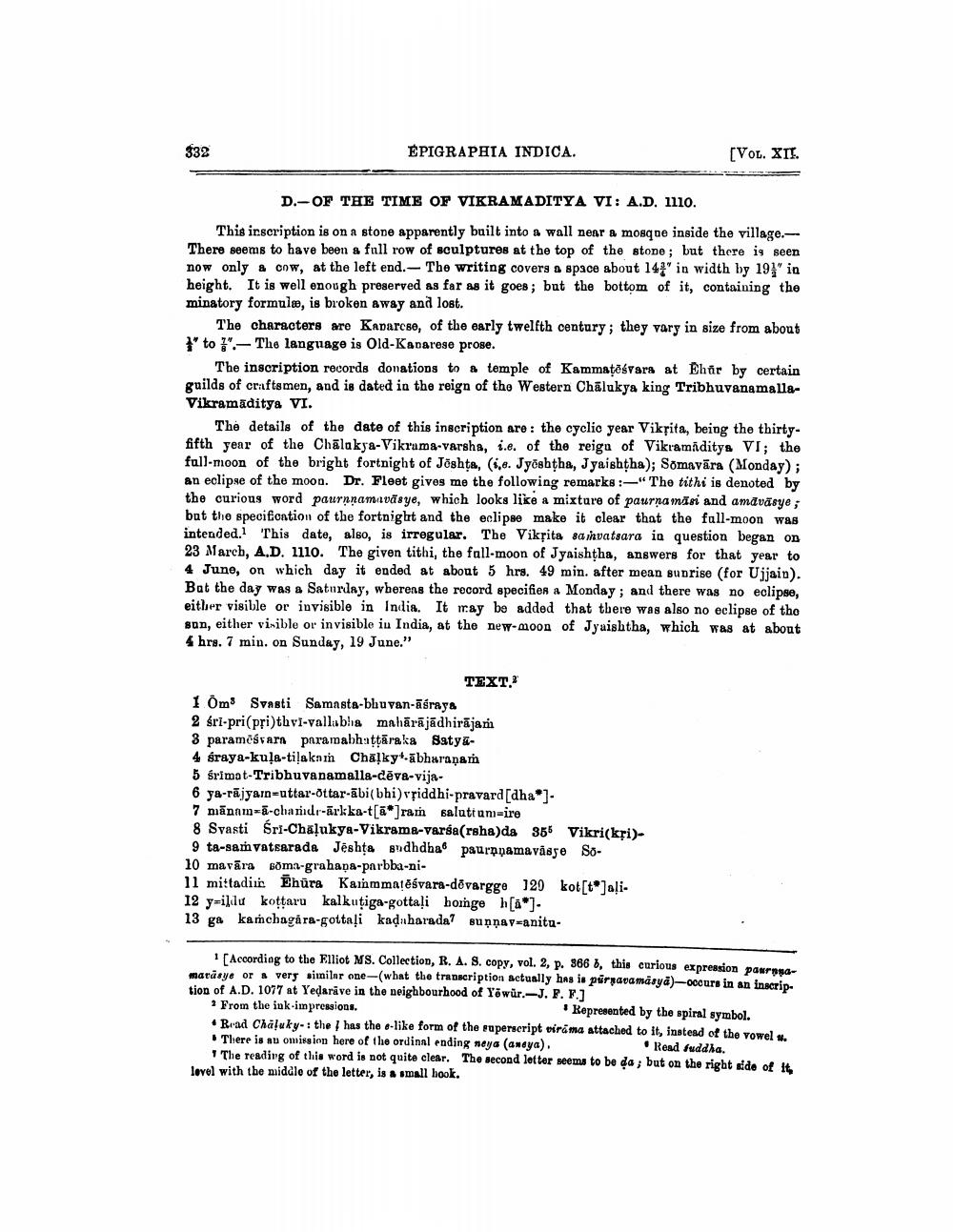________________
332
EPIGRAPHIA INDICA.
[VOL. XII.
D.-OF THE TIME OF VIKRAMADITYA VI: A.D. 1110.
This inscription is on a stone apparently built into a wall near a mosque inside the village. There seems to have been a full row of sculptures at the top of the stone; but there is seen now only & cow, at the left end. - The writing covers a space about 141" in width by 191" in height. It is well enough preserved as far as it goes; but the bottom of it, containing the minatory formulæ, is broken away and lost.
The characters are Kanarcse, of the early twelfth century; they vary in size from about ito .-The language is Old-Kanarese prose.
The inscription records donations to & temple of Kammatosvara at Ehär by certain guilds of craftsmen, and is dated in the reign of the Western Chālukya king TribhuvanamallaVikramaditya VI.
The details of the date of this inscription are: the cyclic year Vikrita, being the thirtyfifth year of the Chalakya-Vikruma-varsha, i.e. of the reiga of Vikramaditya VI; the full-moon of the bright fortnight of Joshta, (1.6. Jyēsbtha, Jyaishtha); Somavāra (Monday); an eclipse of the moon. Dr. Fleet gives me the following remarks :-"The tithi is denoted by the curious word paurnnamuvāsye, which looks like a mixture of paurna misi and amdväsye; but the specifcation of the fortnight and the eclipse make it clear that the fall-moon was intended. This date, also, is irregular. The Vikțita samvatsara in question began on 23 March, A.D. 1110. The given tithi, the fall-moon of Jyaishtha, answers for that year to 4 June, on which day it ended at about 5 hrs. 49 min. after mean suprise (for Ujjain). Bat the day was a Saturday, wherens the record specifies a Monday; and there was no eclipse, either visible or invisible in India. It may be added that there was also no eclipse of the sun, either visible or invisible in India, at the new-moon of Jyaishtha, which was at about 4 hrs. 7 min. on Sunday, 19 June."
TEXT. 1 Om Svasti Samasta-bhuvan-āśrays 2 sri-pri(pri)thvi-vallabha mahārājādhirājan 3 paramēśvara paramabhatýāraka Satya4 sraya-kula-tilakam Chaľkyt-abharanam 5 frimat-Tribhuvanamalla-dēva-vija6 ya-rājyarn-uttar-Ottar-ābi(bhi) vsiddhi-pravard[dha ]7 mānam-ā-charidr-ārkka-t[@]ram saluttum=ire 8 Svasti Sri-Chalukya-Vikrama-varga(rsha)da 356 Vikrickpi)9 ta-samvatsarada Jeshta Budhdha pauranamaviaye So10 mavāra soma-grahana-parbba-ni11 mittadi. Ehura Kammmatēśvara-dēvargge 120 kot[t]aļi. 12 y-illu kottaru kalkuţiga-gottaļi bonge h[al13 ga kamchagára-gottaļi kadaharada? suņņay-anitu
i
1 Accordiog to the Elliot MS. Collection, R. A. S. copy, vol. 2, p. 366 b, this curious expression panrossmaràsye or a very similar one-(what the transcription actually has is pirpanamasya)-occurs in an inscrip. tion of A.D. 1077 at Yedarave in the neighbourhood of Yöwür.-J. P. F.] ? From the ink-impressions.
Represented by the spiral symbol. • Road Chaluky: the has the e-like form of the superscript viroma attached to it, instead of the vowel . There is an omission here of the ordinal ending neya (anaya).
Read fuddha. 1 The reading of this word is not quite clear. The second letter seems to be da; but on the right side of it Lovel with the middle of the letter, is a small hook.




